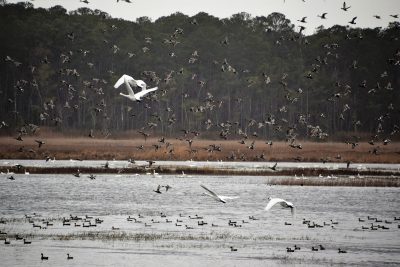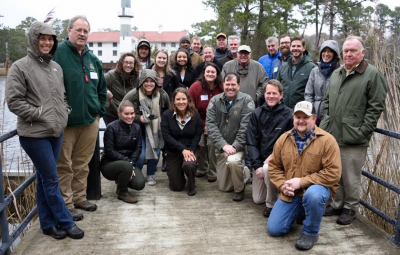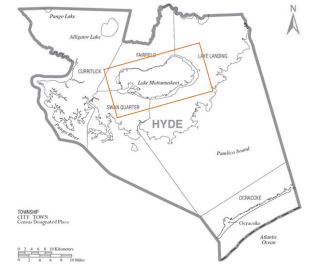HYDE COUNTY — A casual observer gazing out over the serene waters of the 40,000-plus acre Lake Mattamuskeet may not know that the lake is in trouble.

But the state’s largest natural lake, the centerpiece of the 50,180-acre Mattamuskeet National Wildlife Refuge on the Albemarle-Pamlico Peninsula, needs help.
Supporter Spotlight
In recent years there has been declining water quality due to an excess of nutrients and suspended sediments, increasing water levels, recurrent algal blooms, and the majority of submerged aquatic vegetation, an important habitat for fish and food source for the migratory waterfowl, had disappeared by 2017.
Hyde County, United States Fish and Wildlife Service, which manages the refuge, and North Carolina Wildlife Resources Commission, in partnership with the North Carolina Coastal Federation and the community, have been collaborating on a plan to save the lake.
The work paid off.
After nearly two years of planning, the North Carolina Department of Environmental Quality’s Nonpoint Source Planning Branch approved last week the Lake Mattamuskeet Watershed Restoration Plan, which includes the history of the lake, how it functions, the lake’s health and identifies several ways to address water quality and flooding issues. The approval makes the plan eligible to apply for restoration implementation funds administered by the state, according to the federation, which publishes Coastal Review Online.

“This approval helps to propel efforts forward to address the water quality and flooding problems that plague Lake Mattamuskeet,” said Todd Miller, executive director for the federation, in a statement. “It took the entire community that cares about the lake to devise this plan and it will continue to require everyone’s participation to execute the plan so the lake can be restored as one of North Carolina’s environmental treasures.”
Supporter Spotlight
Established in 1934, the refuge, which consists of open water, marsh, forest and croplands, is along the Atlantic Flyway and attracts more than 200,000 ducks, geese and swans from November through February. About 58,000 visitors make their way to the refuge annually to hunt, fish and observe and photograph wildlife, according to refuge officials.
“The Wildlife Resources Commission considers approval of the restoration plan to be a milestone in our collaborative efforts to reverse the declines in water quality in the watershed,” Doug Howell, migratory game bird coordinator for North Carolina Wildlife Resources Commission, said in a statement.
Michael Flynn, coastal advocate for the federation’s Wanchese office, told Coastal Review Online Thursday that the watershed restoration plan was developed voluntarily to address water quality issues before it was necessary to establish total maximum daily load, or TMDLs, a regulatory tool used to address water quality issues. Each state must develop TMDLs for waters identified on the list of impaired waters, depending on rank, according to the Clean Water Act.

“The Lake Mattamuskeet Watershed Restoration Plan is somewhat unique in that it seeks to address flooding issues as well as implement active water management on primarily agricultural land rather than solely focusing on reducing nonpoint source pollution from stormwater runoff, which is a typical objective of watershed restoration plans that are developed for more urban or suburban areas,” said Flynn, who served as a facilitator with other federation staff during the stakeholder meetings and is the primary author of the watershed restoration plan.
The stakeholders held public meetings to collect feedback and input over the course of 18 months before the final draft was introduced Dec. 3, 2018, during a symposium in Engelhard. The plan was submitted Dec. 7 to the Department of Environmental Quality’s Division of Water Resources. After a July 19 addendum was added, the final approval was given Aug. 7, according to the federation.
“Approval of the plan is excellent news and a tribute to the partners and stakeholders who worked diligently for two years to get us to this point,” Pete Campbell, refuge manager for Mattamuskeet National Wildlife Refuge, said in a statement. “Now the time to cooperatively implement the plan’s strategies begins!”
Flynn explained in an interview that the NCDEQ Nonpoint Source program approval meets the main eligibility requirement for the 319 grant program.
“The EPA distributes funds to state governments who in turn distribute funds to eligible candidates to implement water quality restoration activities under section 319(h) of the Clean Water Act,” he continued. “So, in short the approval means that Hyde County or the federation can apply for these funds to implement priority management actions that are identified in the plan. This did not preclude us from applying to other funding sources, but the approval does provide additional validity since it has been reviewed by subject matter experts.”

Other funding sources include an application to the Clean Water Management Trust Fund, which they hope to receive a notification of award in November. There is $100,000 in the state budget for flood mitigation activities in Hyde County but that is on hold because of the budget stalemate, Flynn added. They are also looking to apply for the National Fish and Wildlife Foundation Emergency Coastal Resilience Fund and will work on an application to the 319 grant program for next spring.
This funding will be used to implement priority management actions including the development of a hydrologic and hydraulic model of the watershed, develop preliminary engineered designs for how to sheet flow drainage water over existing or restore wetlands, establish a service district and develop an active water management plan, he said.
Funding has been awarded by the National Science Foundation to Randall Etheridge, assistant professor in the engineering department at East Carolina University, and fellow researchers. This group will use the funding to implement a program where undergraduate engineering students will work with the community to develop preliminary engineered plans for projects to be identified in the spring of 2020 through the fall of 2021.
The Fish and Wildlife Service has also submitted a grant application that would fund a carp removal program in Fiscal Year 2022 if awarded. April Lamb, North Carolina State University master’s student has been evaluating the effect of carp removal on submerged aquatic vegetation restoration in several pilot enclosures on the lake, he said.
Flynn explained that the plan was essentially the result of climate change and sea level rise, although a variety of factors are at play.
Originally excavated to drain the lake in the late 1800s and early 1900s, the canals operated on different head pressures between the lake and Pamlico Sound, even when the pump station was not operational, he said. The canals are still in use today to provide drainage when water levels in the lake are higher than the sound. There are gates in place to keep salt water in the sound from entering the lake.
This passive system is no longer providing adequate drainage capacity because the water level in the sound has been rising, resulting in less days throughout the year that the lake can drain, Flynn continued. This will also cause the groundwater table to rise, reducing storage capacity during rainfall and result in flooding neighboring agricultural land and residential property even during minor storms. As a result, farmers need to use pumps to drain the water from the agricultural land in order to save the crops. That water eventually discharges to the lake, carrying nutrients and sediments.
“Sea level rise and more frequent high precipitation rainfall events will exacerbate this issue,” Flynn said.
Flynn added that support from the principal funding partners, community stakeholders and the academic research community has been tremendous. The refuge, located at the center of a watershed, is surrounded by Hyde County residents, farmers, hunters, fishermen and others and working with the diverse group of stakeholders was one of the greatest successes of the entire process.

“The perspective provided by the stakeholder team was a critical component of understanding the historical and current land use and identifying management actions that are both a priority and practical. Those stakeholders relayed the information that was shared during stakeholder and public meetings to other residents who were unable to attend and responses were shared during future meetings,” he said. “Efforts to improve water quality and mitigate flooding within the Lake Mattamuskeet watershed will need to come from cooperative and collaborative partnerships, and I am glad that they are already in place so that we can build upon them.”
Daniel Brinn, water and flood control coordinator for Hyde County and a key partner in developing the plan, said in a statement, “Hyde County has been fortunate to be the beneficiary of some incredible partnerships throughout the process of writing the plan. Now that it has been approved we look forward to utilizing those same partnerships to move towards implementation as we seek to restore the environmental, cultural and historical gem that is Lake Mattamuskeet.”
As the plan is implemented, there will be updates on watershed restoration on the Coastal Federation website.
For more information about the watershed restoration plan, Flynn can be reached at 252-473-1607 or michaelf@nccoast.org.







